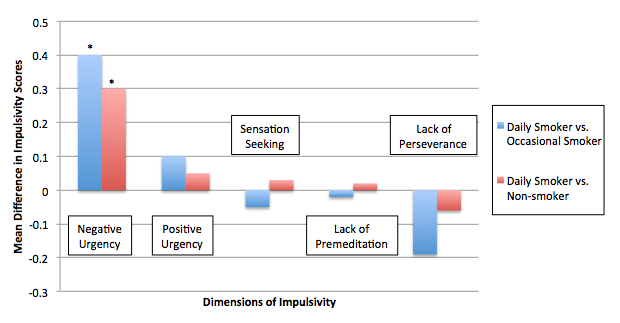ASHES, Vol. 13(3) – A problematic escape: The interaction between smoking and gambling
Gambling disorder (GD) and nicotine dependence are both considerable public health challenges, and they tend to co-occur. Previous research found that 60% of people with GD also experience nicotine dependence, and people with nicotine dependence experience more severe gambling disorder symptoms than those without. Why do these conditions co-occur? One possibility is that impulsivity increases risk for both conditions. This week, as part of this month’s Special Series on Gambling Disorder, ASHES reviews a study by Celina Boothby and colleagues that investigates the links among impulsivity, nicotine dependence, and GD among an online sample of individuals who gambled in the past year.
What was the research question?
Among people who gamble, does impulsivity explain the interaction between gambling disorder and smoking status?
What did the researchers do?
Boothby and her team used MTurk, an online tool used to recruit clinical trial participants. Participants (N = 564) were eligible if they reported gambling in the last year. Researchers used the 9-item Problem Gambling Severity Index (PGSI) to measure GD severity. They used a cutpoint of 5+ to classify people with GD, based on past research. Researchers also measured 5 different dimensions of impulsivity: negative urgency and positive urgency (impulsive behavior in response to negative or positive emotional states, respectively), sensation seeking (chasing exciting or thrilling activities), lack of perseverance (difficulty remaining focused on tasks), and lack of premeditation (failure to assess consequences of actions). Participants also reported whether they smoked 1) daily, 2) occasionally, or 3) not at all.
What did they find?
The researchers honed in on negative urgency. Among participants who qualified for GD (37.6% of the sample), those who smoked daily scored significantly higher on this dimension — but not any of the other dimensions — than those who smoked occasionally or not at all (see Figure 1). For participants who did not qualify for GD, smoking status was not associated with negative urgency scores. More generally, participants who qualified for GD had significantly higher scores on all 5 dimensions of impulsivity than others.

Figure. The mean difference in impulsivity dimension scores for people with GD who smoked daily, occasionally, or not at all. Asterisks represent significant differences between groups. Click image to enlarge.
Why do these findings matter?
Past research has suggested that negative urgency is associated with multiple types of addictive behaviors, including gambling. This study increases our understanding by suggesting that the tendency to act impulsively to escape bad feelings might help explain why smoking and gambling excessively often co-occur. People high in negative urgency might benefit from treatments that teach them to interrupt the tendency to act impulsively when distressed.
Every study has limitations. What were the limitations in this study?
This study used a very narrow definition to define smoking status. The researchers only measured current smoking frequency and only included cigarette use. Therefore, these results might not be generalizable to former smokers or smokers who use other tobacco products.
For more information:
If you or a loved one wants to quit smoking, here is a list of resources from the CDC. If gambling is negatively affecting your life or others, please visit our First Steps to Change website. For additional tools, please visit the BASIS Addiction Resources page.
— Layne Keating
What do you think? Please use the comment link below to provide feedback on this article.